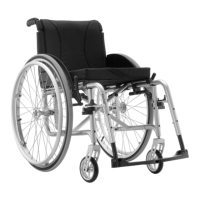REAR WHEELS
Adjusting the rear seat height
Diculty:
Tools:
à 5 10, 19, 22
Loosen the bolt of the adapter sleeve and bolts .
Remove bolts and move the adapter plate into the required
position.
Insert bolts at the appropriate height.
Insert the bolt of the adapter sleeve .
Tighten bolts and .
Tighten the bolt of the adapter sleeve .
Perform the same setting on both sides.
i
After the SHh is changed, the steering error angle must be
checked Chap. Front wheels; Setting the steering error angel,
Correcting the trial angel and with a wheel camber of 3° the angle
of the rear wheels must also be checked, Chap. Rear wheels;
Changing the wheel camber.
i
After the SHh is changed, distance sleeves may also have to be
fitted in order to increase the distance to the rear wheels.
Tipping stability
The tipping stability is influenced by the rear wheel being fitted
further forward or further backward on the adapter plate. The further
back the adapter sleeve is fitted, the greater the tipping stability of the
wheelchair.
If the rear wheel is to be fitted even further back, a rear wheel exten-
sion can be fitted to increase the tipping stability even more.
Adjusting the position of the rear wheel on the adapter
plate
Diculty:
Tools:
19, 22
1
Remove the adapter sleeve .
2
Set the adapter sleeve at the required position in the
adapter plate and tighten the nut securely.
Perform the same setting on both sides.
i
Parking brakes and mudguard must be repositioned if the position
of the rear wheel is changed.
Fitting the rear wheel extension
Diculty:
Tools:
à 5 10, 19, 22
1
Remove the adapter sleeve and adapter plate .
2
Position the adapter plate for the rear wheel extension at the
required height and tighten securely on the counterpiece using
bolts and . Set the adapter sleeve at the required position
in the adapter plate and tighten the nut securely.
1
2
3
4
1
2
1
2
1
2
1
3
5
6
4
à 33 Nm
à 13 Nm
à 13 Nm
à 13 Nm
à 33 Nm
à 13 Nm

